Pitru paksha (Mahalaya) (Shraddha) information, importance, significance
Namaste friends, how are you doing today? Welcome to #BhagavanBhakthi website / blog.
Bhagavan Lord Sri Krishna blessings to you and your family!
In this website / blog, you will always learn about #Hinduism #Sanskrit language.
Also subscribe to my YouTube channel from this link #BhagavanBhakthi to view videos about #Hinduism #Sanskrit language.
Just before moving towards to know about “Pitru paksha (Mahalaya) (Shraddha) full information, importance, significance“, let us know few basic and important information.

First of all let’s know what is ‘pitru‘, ‘paksha‘ and ‘mahalaya‘ are:
Pitru = Pitru (Pitrus) are the group of our ancestors who have passed away and are staying at various other planets.
In simple words, Pitru (Pitrus) are our forefathers.
Paksha = It is the fifteen days period of the Mahalaya month.
Each of the Hindu months are divided into 15 days of two Pakshas, that is, one is Shukla Paksha and another is Krishna Paksha.
In this, the 16 days (Padya to Amavasya) are kept especially for the Pitru Paksha Mahalaya each year.
Mahalaya = This total 16 days of the Pitru Paksha is known as the Mahalaya (Maha + Alaya = Greatly + auspicious period) month for the Hindus.

So that, anyone who has lost his father has to perform this divine ritual every year without miss.
Let us learn step by step about ‘Pitru paksha tarpana, rituals, shraddh (shraddha) significances‘.
List of Pitru paksha (Mahalaya) (Shraddh) full information (unknown facts) are as given below:
Why we do tila (til) (sesame) tarpana to our pitrus
Importance of Darbh (Darbha)
Why ‘Kaka bali’ during Shraddh (Shraddha) period
Why we need to do shraddh (Shraddha)?
THE APPROPRIATE TIME FOR PERFORMING SHRADDH (SHRADDHA)
Shraddh (Shraddha) Kalpa meaning
How to invite Brahmins to Shraddh (Shraddha) ceremony
How many Brahmins need to be invited
How to perform Shraddh (Shraddha)
Shraddh (Shraddha) mantra
The rituals of pinda daanam
Balivaishva Deva
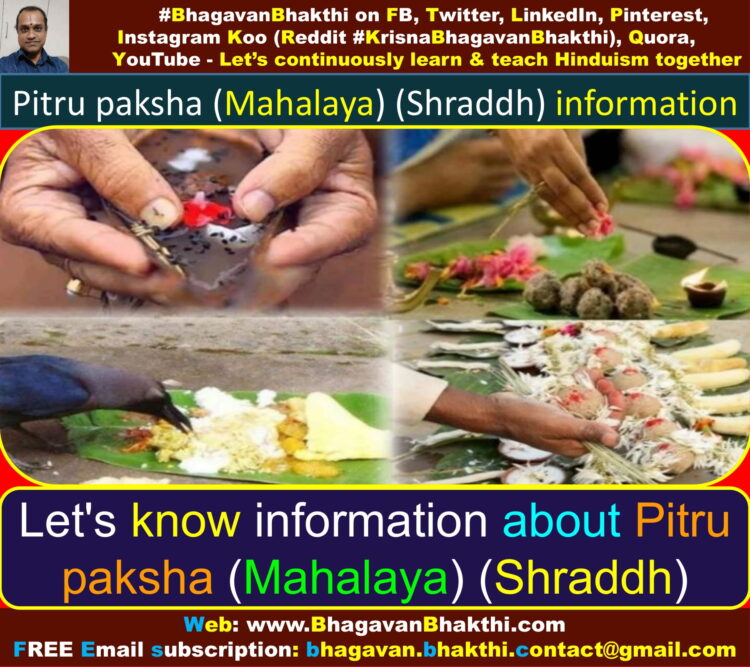
Now, let us know all the above in more details
Why we do tila (til) (sesame) tarpana to our pitrus?
The abhimani Devata (Controlling Demigod) of tila (til) (sesame) is Lord Sri Chandra Deva.
This tila (til) / sesame is also beneficial in the development of Lord Sri Chandra Deva.
The Lord Sri Chandra Deva’s spots / scars are the food to the Pitrus, that is ’tila’ (til) (sesame) acts as the spots / scars of the Sri Chandra Deva.
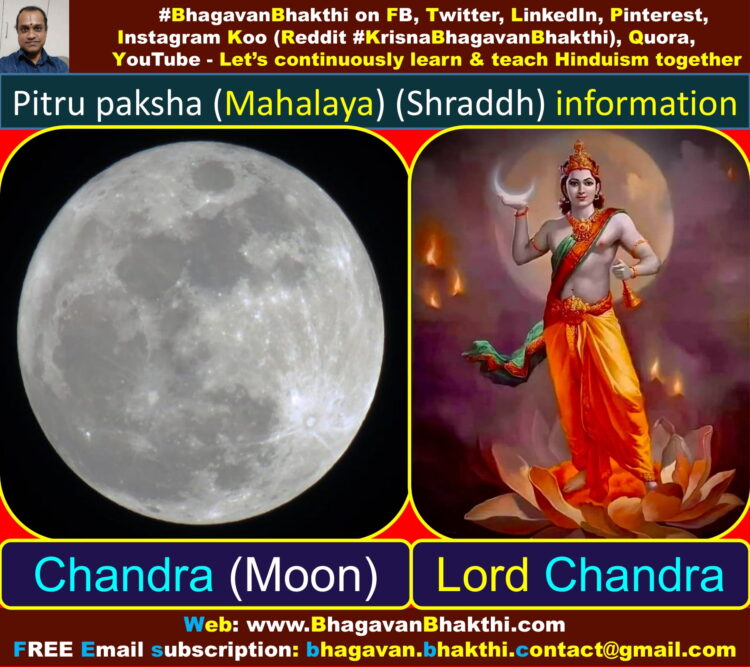
Thus, since this ’tila’ (til) (sesame) is very dear to Lord Sri Chandra Deva, same tila (til) (sesame) is also very dear to our ancestors.
Since Sri Surya Deva (Sun God) is the cause for the day time and night time for the people of earth.
Similarly, Sri Surya Deva’s light is also making the planet of our Pitrus to get day time and night time.
On earth, it takes 24 hours for our one whole day and night.
Similarly on Chandra’s planet, it takes about 15 days and 15 nights of our earth’s time to get Chandra’s one day.
This means earth’s 15 days and 15 nights is equal to Chandra’s (Moon’s) one whole day (day time + night time).
From ashtami of Shukla Paksha until ashtami of Krishna Paksha makes Pitrus’ one night.
And similarly from Krishna Paksha ashtami until Shukla paksha ashtami makes one day time for our Pitrus.
This means, one whole month on earth (15 days of Krishna Paksha + 15 days of Shukla Paksha) is equal to one day on our Pitrus’ planet.
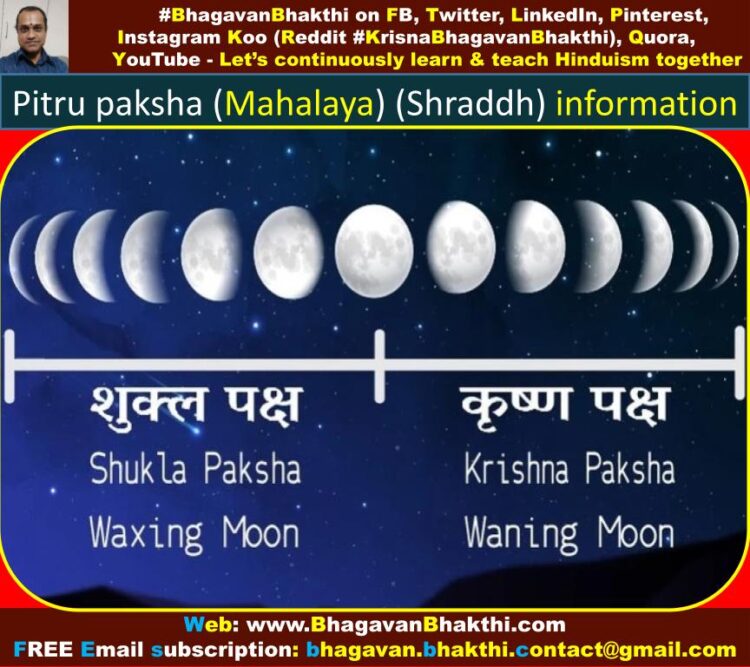
During this one day of Pitrus’, it will be afternoon to our Pitrus, that is, it will be amaavasya according to our Pitrus planet.
Thus we do the tila tarpana for our Pitrus at this time frame.
During the ‘dakshinayana’ kanya maasa, Sri Surya Deva will be at it’s very closest distance to our earth.
For this reason for our Pitrus, tila tarpana on the amaavasya is having greatest significance.
Importance of Darbh (Darbha) (Darbe) information is as given below:
Why Darbha / Darbh / Darbe is called as pavitra?
Darbha (Darbh) / Darbe (a grass type of thing which is used during the shraddh (shraddha) ceremony as a ring for the finger).
Kusha, Barhi, Pavitra are the different names used for the darbha (darbh) / darbe.

Story of Darbha (Darbh) (Darbe) grass is as given below:
Once, Lord Sri Garuda Deva brought Amrita from Lord Sri Indra Deva to save his mother Sri Vinata Devi from the dasya (servitude) of Sri Kadru Devi’s (the mother of Snakes) children (all serpants).
And told these serpents to come with cleanliness to drink the amrita.
As told by Lord Sri Garuda Deva, all the serpents went to get cleansed through snana (bath).
Before they could turn out, Lord Sri Indra Deva snatched the Amrita and kept it on the Darbha (Darbh) / Darbe (grass).
While snatching the Amrita, a drop of Amrita fell on the Darbha (Darbh) / Darbe (grass), which made it pavitra / purified.
That is why Darbha (Darbh) / Darbe (grass) is called as Pavitra (divinely clean).
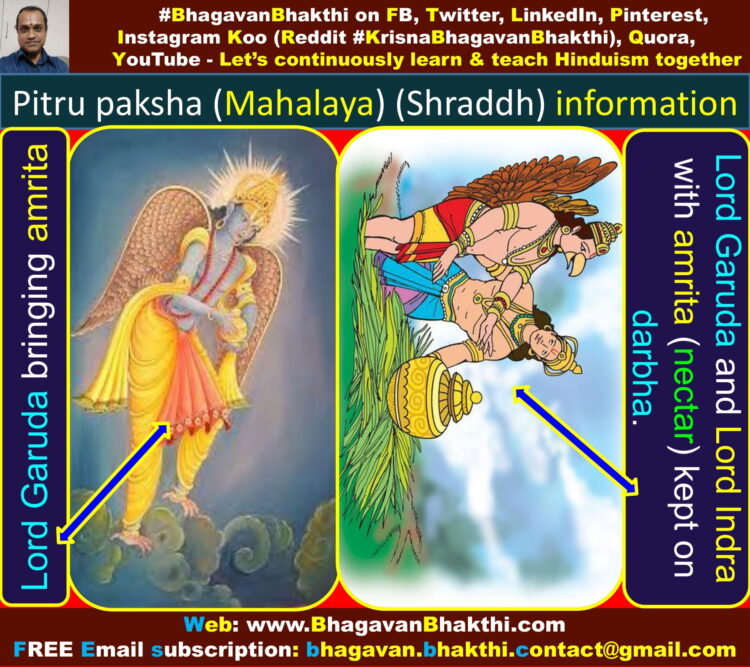
Why ‘Kaaka (Kaka) (Kak) bali‘ during shraddh (shraddha) period?
First of all let us know that ‘Kaaka (Kaka) (Kak) bali‘ means providing ‘anna‘ (boiled rice food) to ‘Kakas’ (to crows).
It’s not at all killing of crow(s) as few people imagine.
On behalf of the dead person, ‘Kaaka (Kaka) (Kak) bali‘ is given.
This has been a long ceremony which we Sanatana Dharma people are following since ages.
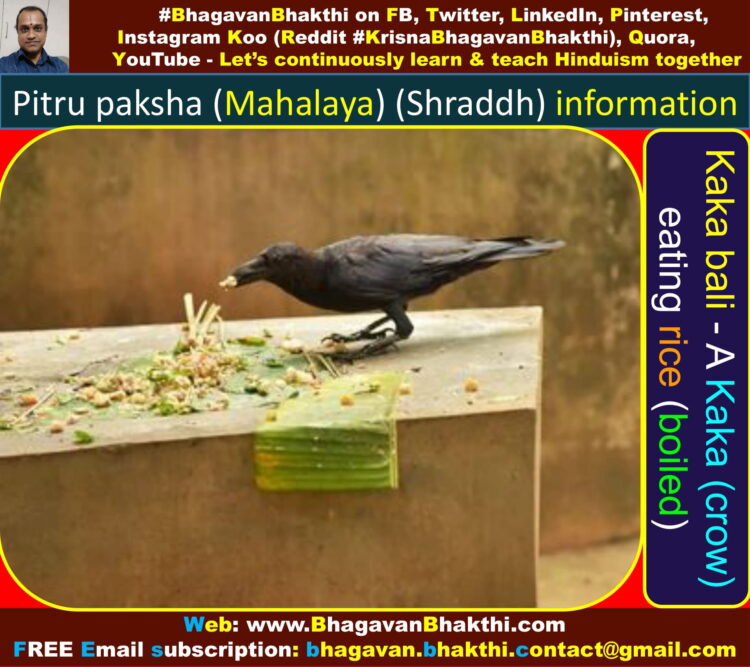
Story about Kaaka (Kaka) (Kak) bali is as given below:
When Ravana was the king, in the priesthood of the Rishi Samvarta, the brother of the Surya Vamsha’s (Vansh) king, Marut Brihaspati did one yagna.
Since at that time Ravana was the king on the earth, all the Devatas / Demigods had come down to earth in disguise of different birds and animals because of the fear of the asura king Ravana.
Lord Sri Indra Deva had come in the form of the bird Peacock, Lord Sri Brahma Deva had come in the form of the birh ‘Hamsa’,
Lord Sri Yama Deva had come in the form of ‘Kaaka’ (Kaka) (Kak) (crow) and others had come in different birds and animals’ forms.
As all these Devatas had come in different forms of birds and animals had given ashirvaadam / blessings to all those birds and animals.

Here Lord Sri Yama Deva given the ashirvadam / blessings to all the ‘Kaakas’ (crows) to live long life without any diseases.
For this reason, even today crows don’t get any disease and have long life. Even though they die, the death cause will not be a disease.
Similarly, Sri Yama Deva also gave another ashirvadam / blessings like this:
“the people who live in my loka (Yama loka), if shraddh (shraddha) food is provided which are given by their children in the form of ‘pinda’,”
“then these people who live in my loka (Yama loka) will get the tripti (satisfaction)”.
Thus for this reason, during the shraddh (Shraddha) kala (period) through the ‘Kaaka bali‘ food is provided to all the Pitrus.

One may think, how can if the children provide the food to ‘Kakas’ (crows) can go and reach to their Pitrus who stay in other lokas?
This is a common question that arises in today’s people of Kali Yuga.
This question arises especially by the so called highly educated people.
Sanatana Dharma has answers to all the questions. Let us know how?
Just imagine a well materially educated person will be working in America.
He / She will be earning a lot and also he / she is a sajjana / sajjani, means he / she is having great love in his / her parents.
But can’t come back to India, while his / her parents are staying back in India.
Now, he / she who works in American sends money in the form of US dollars in one of the banks which is located in America.
The money sent is in the form of US dollars and also from some other bank.
This American bank has tie up with the bank (parents’ bank) situated in India through some agreements and internet connection.

Even though the money sent by he / she is in the form of US dollars and from some other bank.
But still the money reaches to his / her parents in the form of Indian Rupees (INR) ₹ in one of the banks which is located in India.
This means, the money which was sent in dollars from an American bank has reached to his / her parents in the form of Indian Rupees in an Indian bank.
This is the right connection.
The food you may provide to the ‘Kakas’ (crows) through ‘pinda‘.
But still that food goes and reaches the correct Pitrus and not to some other Pitrus.
It will definitely goes and reaches to our Pitrus only and not to other Pitrus.
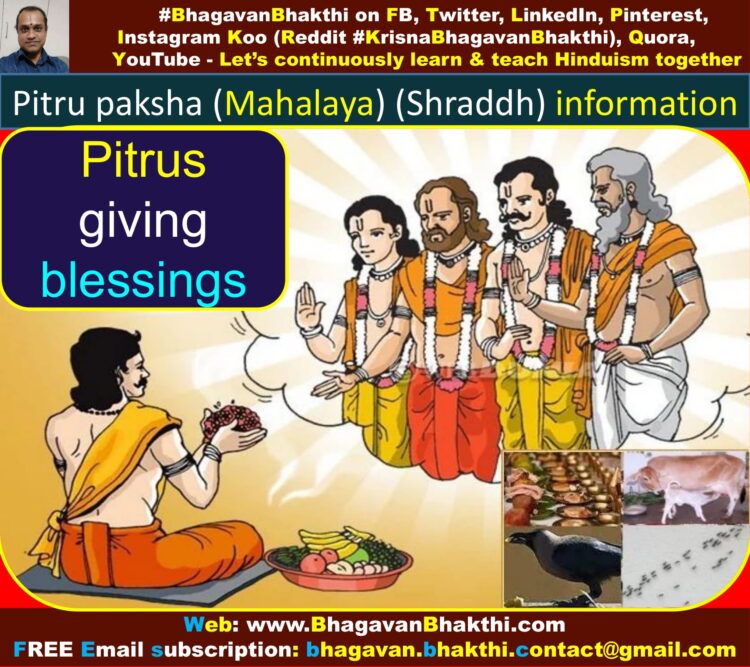
This the greatness of our Great Sanatana Dharma.
If you believe in Sanatana Dharma, it will help you in your growth.
If you don’t believe in Sanatana Dharma, definitely it won’t help you.
Always remember,
‘धर्मो रक्षति, रक्षितः’ | ‘ಧರ್ಮೋ ರಕ್ಷತಿ, ರಕ್ಷಿತಃ’ | ‘dharmo rakshati, rakshitaha’
If you are in the path of ‘dharma‘ means, ‘dharma‘ will definitely save us.
If we are not in the path of ‘dharma‘, then ‘dharma‘ will also provide fruits as per our Karma. This is 100% guaranteed.
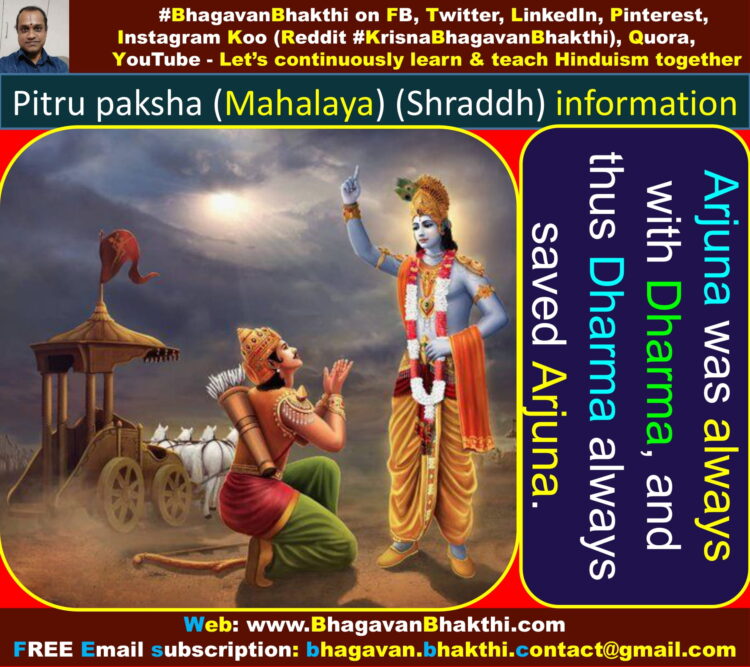
Why we need to do shraddh (shraddha)?
We should always be proud of been born on the Greatest part of the world ‘Bharata / Bharat Bhoomi (India)‘.
Having born on ‘shrestta karma bhoomi bharata‘ (The greatest land on earth called India), one has to get discharged of the main four rina (rin) (रुण / ಋಣ / r̥ṇa), that is –
Pitru Rina (Runa) (Rin), Deva Runa (Rina) (Rin), Rishi Rina (Runa) (Rin) and Acharya Rina (Runa) (Rin).
‘Pitru Runa (Rina) (Rin)’ can be discharged in the following was as given below:
By getting a male child (this is one of the way and not the only way), by mata-pitru seva, and by performing pitru yagna.
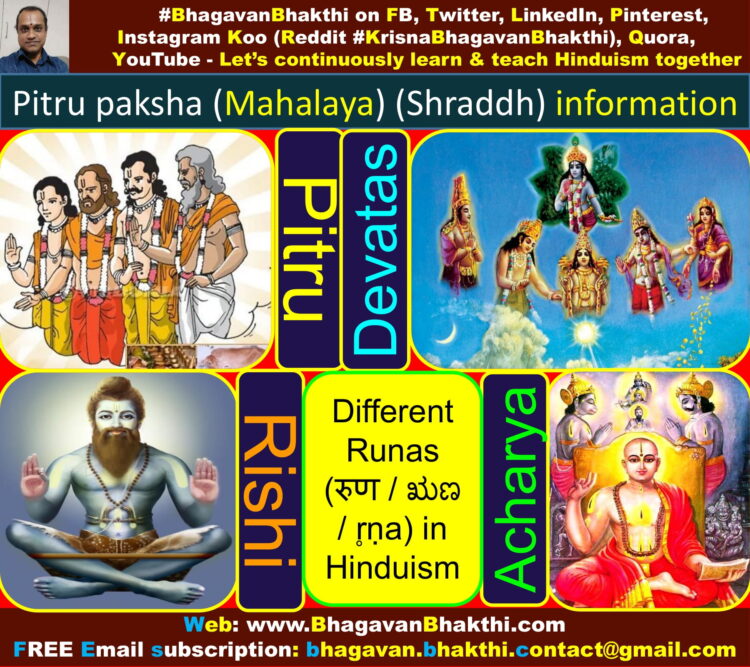
Now let us understand about shraddh (shraddha) according to the Varaha Purana:
Once, sage Markandeya arrived at Naimisharanya to see sage Gauramukha.
Sage Gauramukha was delighted to find such an enlightened soul at his hermitage.
After the formalities were over, Gauramukha requested him to shed light on the venerability of ancestors and the significance of shraddh (shraddha) rituals.
Sage Markandeya replied – Lord Brahma Deva, after having created the sapta rishis (seven divine sages), instructed them to worship him (Lord Brahma Deva).
But they became so arrogant that they started to worship themselves.
Lord Brahma Deva felt insulted and so he cursed them of becoming bereft of all the knowledge.
In course of time, the sapta rishis had numerous sons.
After the death of the sapta rishis, all the sons performed shraddh (shraddha) so that their souls could rest in peace.
(Please remember that in every Kalpa, different Saptarishis are born.)
The Saptarishis were also famously known as ‘Vaimanika‘, because they had manifested from the mind of Brahma Deva.

Sage Gaurmukha was listening to Markandeya’s utterances with rapt attention.
He asked about the most appropriate time for performing shraddh (shraddha) and also about the number of ‘ganas‘ each of the pitrus (as called pitrus) were supposed to have.
Sage Markandeya replied – Pitrus living in the heaven are known as ‘somapa pitrus‘ are believed to be the most privileged ones among all the pitrus.
They enjoy the most delicious beverage – somaras.
Their life-span extends for the full period of kalpa and they worship ‘marutas‘.
Sage Maricha belongs to this category of pitrus.
Pitrus belonging to the category of ‘vairaja‘ are revered even by the marutganas.
Sanaka comes under this category of pitrus. Each of these pitrus have seven ganas.
Similarly, pitrus known as ‘bhaswara‘ have their abode in the world called ‘santanaka‘.
These pitrus are revered even by the deities as all of them are ‘brahma vadis‘ (one who has realized Brahma / Lord Vishnu).

They again manifest themselves after every hundred yugas.
People belonging to any caste can worship the revered ‘pitrus‘ with an appropriately modified rituals and obviously with the permission of the brahmin.
Some of the prominent pitrus are ‘Vasu‘, ‘Kashyapa‘, ‘Marichi‘, ‘Sanaka‘ etc.
THE APPROPRIATE TIME FOR PERFORMING Shraddh (Shraddha) is as given below:
Describing the auspicious time for performing the rituals of shraddh (shraddha), Markandeya told Gauramukha –
“A person desirous of performing the rituals of ‘kamya shraddh (shraddha)‘ can do so on any of the following days –
a) At the commencement of uttarayana or dakshinayana.
b) At the time when vyatipata yoga takes place.
c) At the time when vishu yoga occurs.
d) During both solar and lunar eclipses.
e) If troubled by the evil influences of a constellation or a planet.
f) If troubled by nightmares.
g) At the time when the Sun changes it’s position from one zodiac to another.
The various nakshatras like Anuradha, Vishakha and Swati are considered to be very auspicious for performing shraddh (shraddha) – especially, if the day happens to be amavasya.
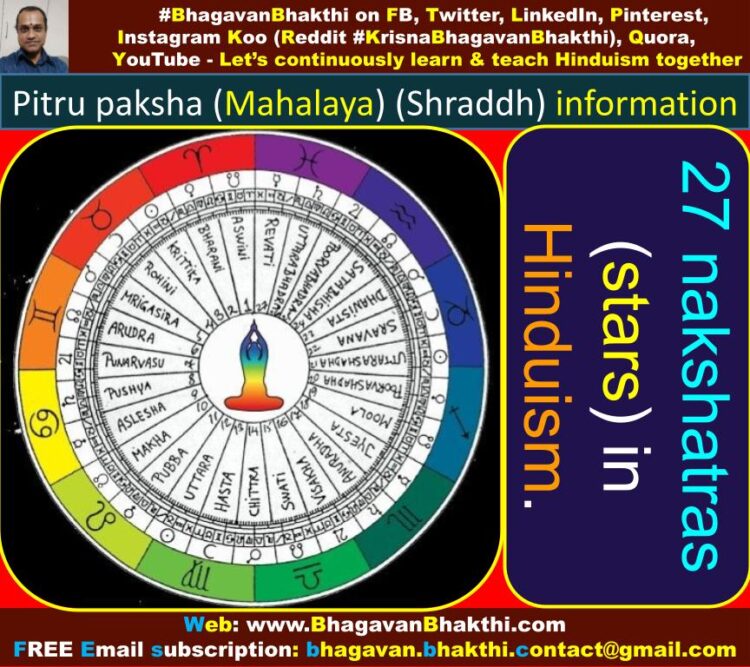
Shraddh (shraddha) performed on such a day pacifies the ancestor’s soul for eight years.
Similarly the combination of amavasya with either ‘pushya nakshatra‘ or ‘punarvasu nakshatra‘ is believed to pacify the ancestor’s soul for twelve years.
Some other days which are considered to be very auspicious for performing shraddh (shraddha) are as given below:
The third day of the bright half of the Hindu month Vaishakha,
The ninth day of the bright half of the Hindu month Kartika,
The thirteenth day of the dark half of the Hindu month Bhadrapada and
Amavasya day falling in the Hindu month of Magha.
A man desirous of performing shraddh (shraddha) can do so on any of the above mentioned days.
He should take bath in a holy river and offer ‘tarpana‘ (libation) to his ancestors.

Shraddh (shraddha) Kalpa meaning is as given below:
Describing the types of Brahmin who are considered to be eligible to preside over the rituals of shraddh (shraddha), Markandeya told sage Gauramukha –
The following types of Brahmins are eligible to perform shraddh (shraddha) – ‘trinachiketa’, ‘trimadhu’, ‘trisuparna’ and the Brahmins who are well versed in all the Vedas.
The shraddh (shraddha) rituals can be performed by any of the following relatives of the deceased, apart from his son-maternal nephew, grandson (daughter’s son), father-in-law, son-in-law, maternal uncle, etc.
Similarly, the following types of Brahmin should never be invited at the shraddh (shraddha) at the shraddh (shraddha) ceremony:
A deceitful or a wicked Brahmin,
A Brahmin who is a habitual backbiter or who is accused of theft,
A Brahmin who has married a shudra woman and
A Brahmin who earns his livelihood by working as a priest.
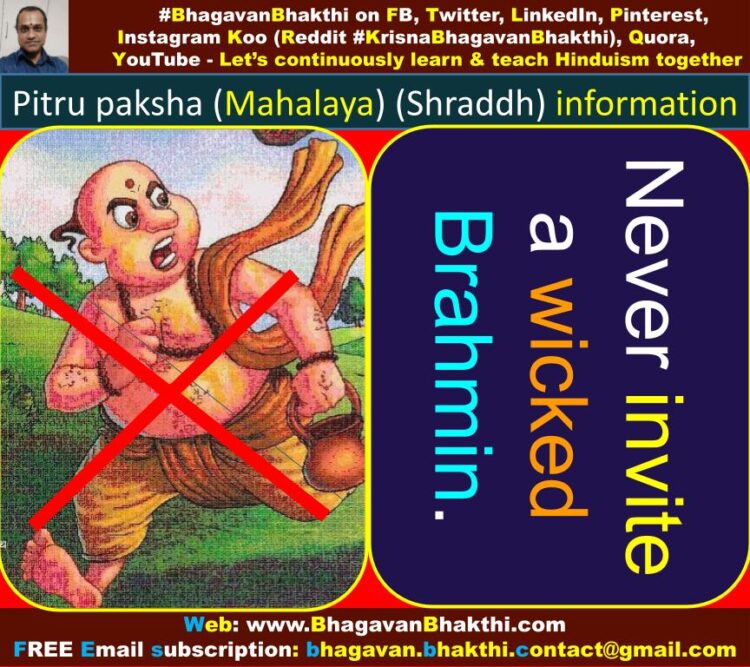
How to invite Brahmins to Shraddh (Shraddha) ceremony is as given below
Invitation should be given to the all the Brahmins one day in advance.
If uninvited Brahmins arrive to attend the shraddh (shraddha) ceremony, they should be treated with due respect.
The Brahmin who is supposed to perform the rituals should wash the feet of other Brahmins to show his respect towards them.
He should then help them perform ‘achamanam‘ (rinsing of mouth).
Finally, the invited Brahmins should be fed after the rituals have been completed.
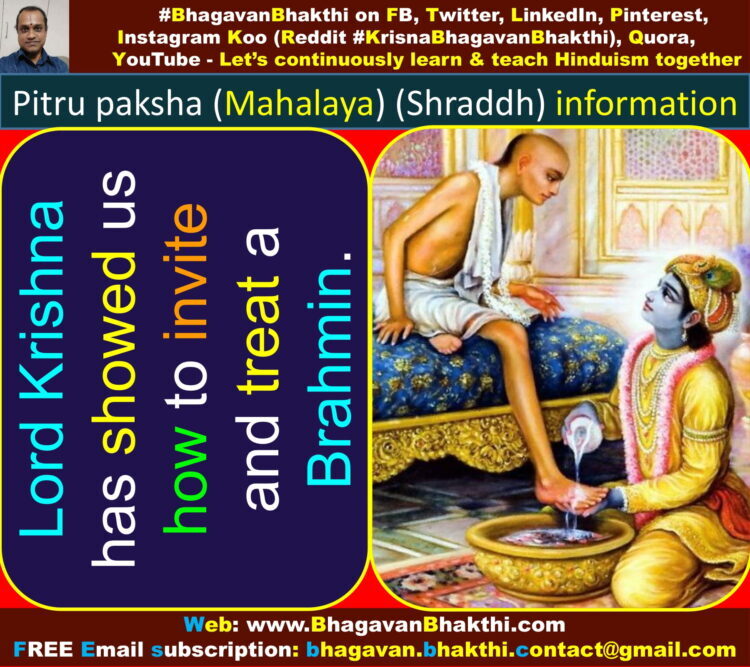
How many Brahmins need to be invited for Shraddh (Shraddha) is as given below:
As far as the number of invited Brahmins to the shraddh (shraddha) ceremony of the ancestors is concerned, the scriptures have strictly put it to odd numbers – one, three, five, etc.
Similarly, the number of invited Brahmins for the shraddh (shraddha) of the deities is concerned the number has been put to even number – two, four, etc.
But, if the person finds it difficult to invite the above number of Brahmins, then he can invite only one Brahmin for both the types of shraddh (shraddha).
While performing the shraddh (shraddha) of maternal grandfather, it is mandatory to perform the shraddh (shraddha) of Vaishyadeva simultaneously.
In the shraddh (shraddha) ceremony related with the deities, the Brahmins should always have their food facing east.
On the contrary, in the shraddh (shraddha) ceremony of the ancestors the Brahmins should have their food facing north.
How to perform Shraddh (Shraddha) is as given below:
A person performing the shraddh (shraddha) rituals should have his seat made of ‘kusha‘ grass.
After taking his seat, he should invoke the deities and make offerings of ‘arghya‘ to them.
While offering ‘arghya‘ to the deities, water and barley are commonly used along with other articles like sandalwood, incense, etc.
During the entire course of shraddh (shraddha) rituals ‘yagyopaveetam (janeu)‘ (divine sacred thread) should be worn in an inverse position-across the right shoulder and not across the left shoulder as it is normally worn.

While performing the shraddh (shraddha) of ancestors offerings of articles like sesame seeds, water and kusha grass are normally made.
Shraddh (Shraddha) mantra
It is customary to scatter tila (til) (sesame) seeds near the place where Brahmins are having food in the shraddh (shraddha) ceremony.
The performer of the shraddh (shraddha) rituals should imagine that the food partaken by them are actually satiating the ancestors.
The chanting of ‘Rakshodhna mantra‘ is a must.
The rituals of pinda danam is as given below:
One important characteristic of the rituals connected with ‘pinda danam‘ is the offerings made to manes in the form of tila (tila) (sesame) seeds and water.
Another important aspect is that ‘pinda‘ is offered on the ‘kusha‘ grass which are kept facing south-first in the name of one’s dead father and then in the name of one’s grandfather and other ancestors.
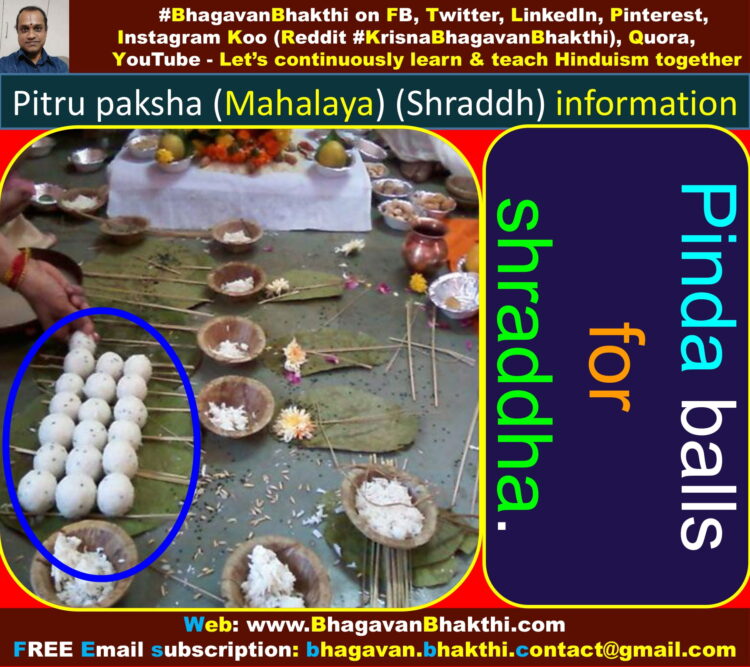
Balivaishva Deva information is as given below:
The performance of Balivaishva deva rituals mark the end of shraddh (shraddha) ceremony after which the person should sit down along with all the invited guests to have his food.
Ancestors become satisfied if shraddh (shraddha) is performed in their names and all the desires of such a man are fulfilled.
Three things have great importance in shraddh (shraddha) rituals, that is –
Black tila (til) (sesame) seeds, the auspicious muhurta named ‘Kutupa‘ and grandson (daughter’s son).
Donating silver is considered to be extremely auspicious.
A person performing the shraddh (shraddha) rituals should not venture out of his house till the completion of the entire ceremony.
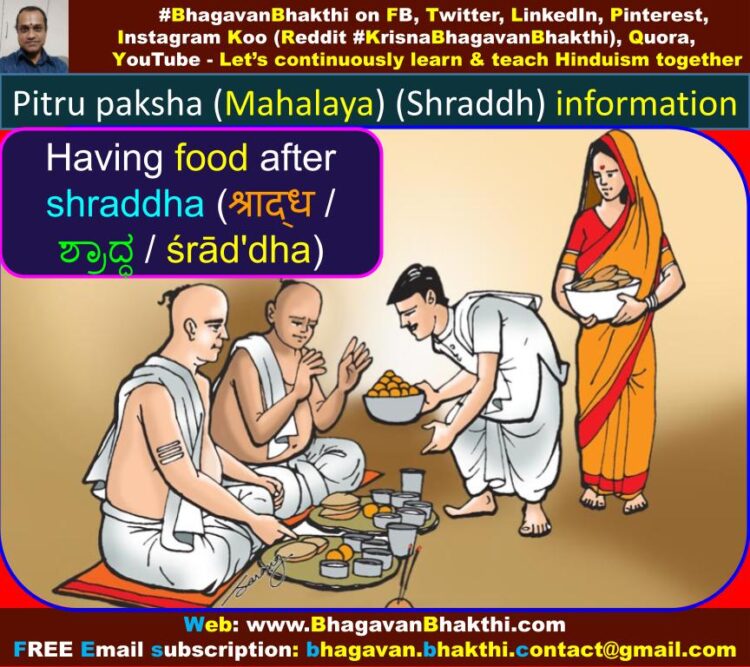
Why Pitru Paksha (Mahalaya) is be observed during this period
For Pitru Devatas one month of Human period is equal to one day (as discussed above), and shukla paksha is the day and Krishna paksha is the night for Pitrus (Please see earlier discussion about this).
What we are giving as ’tila tarpana’ and ‘pinda pradaana’ during the said period will be sufficient for Pitrus throughout the year (remember that our one year is one day for our Pitrus, according to the Pitrus’ time frame).
That is why one should be performing the shreshta ‘paksha’ (shraddh / Shraddha) during this 15 days of period.
The rituals performed during this 15 days of the ‘mahalaya’ are considered important and considered equal to that being performed in holy places like Gaya.
Means, in other days, we need to go to Gaya and perform the ‘shraaddha’ ceremony.
But it is very difficult for many of us to go Gaya and to do the ‘shraddha’ ceremony.
Thus Bhagavan Sri Maha Vishnu has provided this ‘mahalaya’ period for us to complete the shraaddha and it is very easy, less time is consumed and also the cost is also limited.
Offerings made to the Pitrus during this fortnight reach them directly as ordained by Sri Yama Deva. Offerings reach all departed souls, whether they are directly related to those offering them or not.
Tila or sesame seeds tarpana and pinda pradaana (rice ball) offerings are made to departed Pitrus during the fortnight.
The food offerings reach the dead through the rays of the sun rays.
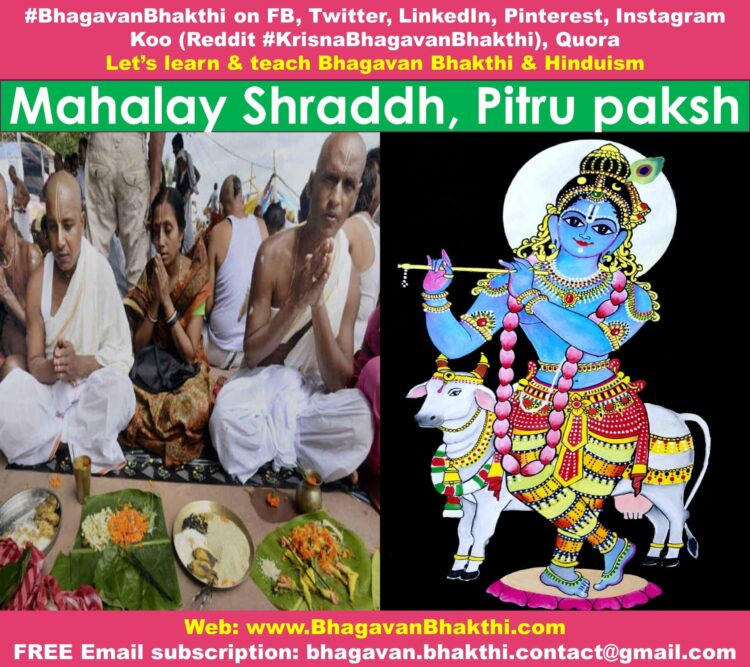
Who should perform this Pitru paksha ceremony
All those whose fathers have passed away, should and must do this Pitru paksha (shraaddha) ceremony during the Mahalaya period (15 days).
Where shraaddha has to be performed
It is advisable to perform at nearby rivers in the teertha sthalaas. But nowadays, since it is not easy to go to the teertha sthalaas, we should at least perform in our houses.
But it should and must be performed without miss.
Dates for Mahalaya Paksha Shraaddha
To be precise, Paksha has to be done on all the 15 days of the Mahalaya Paksha period (On Ekadashi day should be performed without food items).
Atleast tila / sesame tarpana must be given on all the days during paksha maasa.
If one is not able perform the Paksha on all the days, they have to select a day, usually the day of his father’s death day.
For example, if someone’s father has died on dashami, then on dashami tithi day itself shraddha to be done.
If it is inconvenient for a person to do it on dashami, then he can perform on any day other day except the following days – Navami (meant for Avidhava – for those have died as suhagan), Ekadashi (Upavasa), Dvaadashi (meant for Yatis / Sanyasis), Chaturdashi (Ghata Chaturdashi – meant for accident victims).
One can perform on other days. For those who have died on Pournami day, Paksha to be performed on paadya or other convenient day.
If during this entire period, it is not possible to do the paksha, then you can do it during Thula maasam, means, when Sri Surya Deva enters Kanya rashi (upto Ashwayuja bahuLa panchami).
Items required to perform Pitru paksha
Agnistike, Charcoal, Dharba (Kusa grass), plantain leaves, Fruits, plain rice, rice (for naivaidya), tila / black sesame, water,
Tulasi leaves, pavitra (made of darbha / grass), Vishnu padam (Foot print of Bhagavan Sri Maha Vishnu), ghee, curds,
honey, milk, Panchapatra, Uddrana, paan (paan supari’s paan), Adike, Dakshine, yajnOpaveeta (janeev / janeevaara), gopichandana, donne.
While doing shraaddha we should not divert our mood like having unwanted conversation with others or talking over mobile phone etc.
Mahalaya Paksha Shraaddha steps
Aachamana, Pavitradharana, Punarachamana, Yavodaka, Tilodaka, Aamantrana / inviting Brahmana for for darba ritual,
Paada prakshalana, Asana, Arghya, Antaryaami Pooja, Avaahana, Gandha, Mandala, Paatraasaadana,
Darba brahmana bhojana, Pinda Pradana, Pinda Pooja, Bhojana Niyama, Pinda Visarjana, Brahmana Visarjana,
Brahmana Suvasini Bhoori Bhojana Sankalpa, Brahmana Bhojana, taking ashirvaada from Brahmanas, Yajamaana Bhojana, telling Krishnarpana.
NOTE: Mahalaya Shraddha should not be performed during the mruta varsha (first year).
Only after the completion of first year of the death, Mahalaya Shraaddha has to be performed. Means from second year Mahalaya Shraaddha has to be performed.
Will Pitrus Devatas will come to our house if someone performs Mahalaya Paksha Shraaddha
Off course / Indeed. Piturs will definitely come.
Also, Pitru antargata Vasurudra, Adityas antargata Pradyumna sankarshana Vasudeva Roopi Paramathma will come in Vaayu roopa,
they will definitely watch shraaddha karma, eat and will be pleased (if done with proper achara, vichara, bhakti etc).
If shraaddha is not done in a particular house, pitru devatas will wait till suryasta (sun set), and will leave the house with hungry and thirsty, and also curse his family members.
पितृयज्ञ दिनेप्राप्तॆ, गृहद्वारं समाश्रिता: | वायुभूता: प्रवांछंति, श्राद्धं पितृगणानृणां । यावदस्तमयं भानो: क्षुत्पिपासा समाकुला: | निश्वस्व सुचिरं यांति गर्हयंति स्ववंशज: ।
ಪಿತೃಯಜ್ಞ ದಿನೇಪ್ರಾಪ್ತೆ, ಗೃಹದ್ವಾರಂ ಸಮಾಶ್ರಿತಾ: | ವಾಯುಭೂತಾ: ಪ್ರವಾಂಛಂತಿ, ಶ್ರಾದ್ಧಂ ಪಿತೃಗಣಾನೃಣಾಂ | ಯಾವದಸ್ತಮಯಂ ಭಾನೋ: ಕ್ಷುತ್ಪಿಪಾಸಾ ಸಮಾಕುಲಾ: | ನಿಶ್ವಸ್ವ ಸುಚಿರಂ ಯಾಂತಿ ಗರ್ಹಯಂತಿ ಸ್ವವಂಶಜ: |
pitr̥yajña dinēprāpte, gr̥hadvāraṁ samāśritā: | vāyubhūtā: pravān̄chanti, śrād’dhaṁ pitr̥gaṇānr̥ṇāṁ | yāvadastamayaṁ bhānō: kṣutpipāsā samākulā: | niśvasva suciraṁ yānti gar’hayanti svavanśaja: |
Shraddh (Shraddha) Phala (uses)
If we do Mahalaya Paksha Shraaddha, all the Pitrus and Pitru Devatas will be happy and satisfied.
Most importantly the ‘pitrangata‘ (antaryami of Pitrus) Bhagavan Sri Maha Vishnu will be happy and satisfied for the rituals we have performed.
In the Kali Yuga, especially the highly education people will always question this, what will we gain if we do Shraaddha?
In Sanatana Dharma, we have answers for everything and for everyone:
पिता ददाति सत्पुत्रान् गोधनानि पितामह: । धनदाता भवेत्सोपि यस्तस्य प्रपितामह: । दद्याद्विपुलमन्नाद्यं वृद्धस्तु प्रपितामह: । तृप्ता: श्राद्धेन ते सर्वे दत्वा पुत्रस्य वांछितं ।
ಪಿತಾ ದದಾತಿ ಸತ್ಪುತ್ರಾನ್ ಗೋಧನಾನಿ ಪಿತಾಮಹ: | ಧನದಾತಾ ಭವೇತ್ಸೋಪಿ ಯಸ್ತಸ್ಯ ಪ್ರಪಿತಾಮಹ: | ದದ್ಯಾದ್ವಿಪುಲಮನ್ನಾದ್ಯಂ ವೃದ್ಧಸ್ತು ಪ್ರಪಿತಾಮಹ: | ತೃಪ್ತಾ: ಶ್ರಾದ್ಧೇನ ತೇ ಸರ್ವೇ ದತ್ವಾ ಪುತ್ರಸ್ಯ ವಾಂಛಿತಂ |
pitā dadāti satputrān gōdhanāni pitāmaha: | dhanadātā bhavētsōpi yastasya prapitāmaha: | dadyādvipulamannādyaṁ vr̥d’dhastu prapitāmaha: | tr̥ptā: Śrād’dhēna tē sarvē datvā putrasya vān̄chitaṁ |
The meaning of this shloka is as given here : First, if someone perform the Mahalaya Shraddha Paksha, father will bless you with satputraas (children who follow the Great Sanatana Dharma).
Your Pitamaha, that is, your grand father will bless you with Go-daana (cow-wealth),
Your Prapitamaha (Great grand father – Daada Ji) will bless with wealth and property.
Also, they will bless you with food, wealth, shelter, wealth, etc.
Maha Bharani Shraddha / महा भरनी श्राद्ध
Shraaddha Paksha done on the auspicious day of Mahabharani shraaddha day is of great importance.
This is observed during Bhadrapada maasa, Krishna paksha, on the day on which Bharani Nakshatra is present.
Even if you have are doing shraaddha paksha on some other day, this shraaddha Paksha also must be done.
Vyateepata Shraddha / व्यतीपादा श्राद्ध
Shraaddha Paksha done on Vyateepaata shraaddha day is also of great importance.
This is observed during Bhadrapada maasa, Krishna paksha, on the day on which Vyateepaata Yoga is observed.
Even if you have are doing shraaddha paksha on some other day, this shraaddha Paksha also must be done.
Avidhava Navami / अविधवा नवमी श्राद्ध
Here Vidhava means Widow. “Avidhava” means not a Widow – Sumangali (suhaagan).
Avidhava Navami in the context of Pitru Paksha is the day on which ceremonies / rituals are to be performed for those Women (Mothers) who died as Sumangali / Suhaagan.
It should be performed by the son/s on the ‘navami tithi’ day during Pitru Paksha.
Avidha Navami is followed by those who have lost their mothers and their father is alive. They have to do it on Bhadrapada maasa, Krishna Navami tithi day.
They have to invite suhagan-Brahmana Dampati for this ritual and give them kaashta baagina (wood baagina) containing all saumangala items like:
haridra, kumkuma, coconut, rice, dals, blouse peace (cloth), paan & supari, dakshina, if possible sari, etc.
On this day, pinda pradaana has to be done.
At least tila tarpana has to be done.
Here during Avidhava navami, unlike paksha (wherein all the forefathers will be called), only his mother/mother-in-law and great grand mother will be called and pinda pradaana hasto be done.
During Shradha period Bhagavan Sri Maha Vishnu will be there in how many roopas in the kartru and bhoktru?
Janardhana roopa will be there in 3555 roopas.
Shannavathi Shraaddha meaning
Shraaddhaas done on some specific days. That is, there are 96 shraaddhaas to be done in an year. They are as given below:
1. 12 Amavaasya 2. 12 Vaidhruti 3. 14 Manvaadi 4. 12 Vyatipaata 5. 4 Yugaadi 6. 15 Mahalaya 7. 12 Sankramana 8. 15 Ashtaka
(Bhadrapada Bahula saptami, ashtami, navami, Margashira bahula saptami, ashtami, navami Pushya Bahula saptami,
ashtami, navami, Magha bahula saptami, ashtami, navami, Palguna bahula saptami, ashtami, navami)
Thus making a total of 96 roopa of Bhagavan Sri Maha Vishnu will be there in these 96 shraddhas (Shraddhs).
How to do the the chintana of Bhagavan Sri Maha Vishnu during Shraadha time?
1. Svaaha – Mayapati Vasudeva will give trupti to Devatas.
2. Svadaa – Jayapati Sankarshana will give trupti to Devatas.
3. Khaadya, Peya, Lehya, ChoShya – Krutipati Pradyumna will give trupti to Devatas.
4. TruNaadi – Shantipati Aniruddha will give trupti to Devatas.
Dvadasha Pitrugans
Dvadasha Pitrugans means 12 pitrugans, and their name are:
a. Pitruvarga (pitru traya / three Pitrus) – Pitru, Pitaamaha, Prapitaamaha
b. Maatruvarga (maatru traya / three maatrus) – Maatru, Pitaamahi, Prapitaamahi
c. Maataamaha varga – Maataamaha, Maatru:pitaamaha, Maatru:Prapitaamaha
d. Maataamahi varga – maataamahi, maatru:pitaamahi; maatru:prapitaamahi
Who are Paternal Side pitrus (Father’s side pitrus)
1. Pitram (Father) (Vasu roopa)
2. Pitaamaham (Grand Father, that is, Father’s father) (Rudra roopa)
3. Prapitaamaham (Great Grand Father, that is, Father’s paternal grand father) (Aditya roopa)
4. Maataram (Mother) (Vasu roopa)
5. Pitamahim (Grand Mother, that is, father’s mother) (Rudra Roopa)
6. Prapitaamahim (Great Grand Mother, that is, Father’s paternal Grand Mother) (Aditya roopa)
7. Saapatni Janani (Step Mother, that is, if any) (Vasu roopa)
Who are Maternal Side Pitrus (Mother’s side Pitrus)
8. Maataram (Mother)(Vasu roopa)
9. Maataamaham (Grand Father, that is, Mother’s father) (Vasu roopam)
10. Maatru Pitaamaham (Great Grand Father, that is, Mother’s paternal grand father) (Rudra roopa)
11. Maatru Prapitaamaham (Great Great Grand Father, that is, Mother’s paternal Great Grand father) (Aditya roopa)
12. Maatamahim (Mother’s mother)
13. Maatru Pitaamahim (Mothers paternal grand mother)
14. Maatru Prapithamahim (Mother’s paternal Great Grand Mother)
Other Pitrus
1. Aatma Patnim – Wife/wives
2. Tanayaadi – Sutam (son/s)
3. Bhraataram – Bbrother/s
4. Tatpatnim – Brother’s wife/s
5. Pitravyam – Father’s brothers
6. Tatpatnim – Uncle’s wife/s
7. Matrula – Maternal Uncle/s
8. Tatpatnim – Their wife/s
9. Duhitaram – Own daughter
10. Tadbhartaaram – Her husband – Jamaata
11. Dauhitaram – Daughter’s son
12. Aatma Bhagini – Sister/s
13. Tadbhartaaram – Her husband
14. Tatputram – Her sons – Bhagineeyam
15. Pitrusvasa – Father’s sister
16. Tatpatnim – Her husband
17. Maatrusvasa – Mother’s sister
18. Tatpateem – Her husband
19. Jaayaapita – Father-in-law
20. Jaamaata – Mother-in-law
21. Shalaka/Bhavuka – Brother-in-law
22. Tatpatneem – Their wife/wives
23. Gurum – Vidya Guru
24. Tatpatnim – Guru patni
25. Achaaryam – Purohita
26. Tatpatneem – His spouse/s
27. Shishyam – Disciple
28. Aptam – Friend
Note: If name of the Pitru is not known, then Yagnamma for ladies and Yagnappa for gents to be used. If Gotra is not known of the Pitru, then Kashyapa Gotra to be used.
For males ‘gotram’ to be used and for females ‘gotraam’ to be used. For males’ name “sharmanam” and for females “daam” to be added
Rigvedis must tell their name first, followed by gotra, then roopa.
Yajurvedis must tell their gotra first, followed by name and roopa.
On the Shraddha Paksha Day, we must follow some these things very importantly:
a. we must not brush our teeth
b. we must not take taila snaana / oil bath
c. we must not eat taamboola (paan supari)
d. medicines to be taken, only if it is inevitable
e. we must observe brahmacharya
f. rathri bhojana nishiddha
g. after completion of pooja, we must take nirmalya only
h. Previous day night also bhojana nishiddha
i. teertha can be taken only after completion of shraaddha, giving it to brahmana suvagans
j. only one meal per day during entire shraaddha paksha maasa for those who are not having father.
k. morning ‘sandyaavandana’ pooja to be done, then only tarpana to be given
l. tarpana to be given from ‘nirmalya teertha’
m. tila tarpana to be given with pavitra dhaarana or at least nirmalya tulasi
During Paksha/Shraddha “saptanna” in Pinda pradaana
सप्तान्न प्रकरण (हरिकथामृतसार – पितृगणसंधि १४)
एळुविध अन्नप्रकरणव केळि कोविदरास्यदिंदलि आलसव माडदॆलॆ अनिरुद्धादि रूपगळ । कालकालदि नॆनॆदु पूजिसु स्ठूलमतिगळिगिदनु पेळदॆ श्रीलकुमिवल्लभनॆ अन्नादन्न अन्नदनु ॥
ಸಪ್ತಾನ್ನ ಪ್ರಕರಣ (ಹರಿಕಥಾಮೃತಸಾರ – ಪಿತೃಗಣಸಂಧಿ 14)
ಏಳುವಿಧ ಅನ್ನಪ್ರಕರಣವ ಕೇಳಿ ಕೋವಿದರಾಸ್ಯದಿಂದಲಿ ಆಲಸವ ಮಾಡದೆಲೆ ಅನಿರುದ್ಧಾದಿ ರೂಪಗಳ | ಕಾಲಕಾಲದಿ ನೆನೆದು ಪೂಜಿಸು ಸ್ಠೂಲಮತಿಗಳಿಗಿದನು ಪೇಳದೆ ಶ್ರೀಲಕುಮಿವಲ್ಲಭನೆ ಅನ್ನಾದನ್ನ ಅನ್ನದನು ||
“saptanna (seven anna / rice) prakarana” is found in ‘bruhadaranyaka upanishat’.
Sri Madhvacharya Ji has given the explanation in detail in his bhashya on ‘bruhadaranyakopanishat’.
Means, Bhagavan Sri Maha Vishnu prepares seven annaas / rice, that is, मनस् (Manas), वाक् (Vaak), प्राण (Praana), अन्न (Anna), बलि (Bali), होम (Homa), गोक्षीर (Go-ksheera) (ಮನಸ್ಸು, ವಾಕ್, ಪ್ರಾಣ, ಅನ್ನ, ಬಲಿ, ಹೋಮ, ಗೋಕ್ಷೀರ).
Out of them, Bhagavan Sri Maha Vishnu keeps मनस् (Manas), वाक् (Vaak), प्राण (Praana) with himself.
That is why if we do the ‘samarpana’ of मनस् (Manas), वाक् (Vaak), इंद्रिय (Indriya), that will be ‘mahaanaivedya’ to Bhagavan Sri Maha Visnhu.
Fourth अन्न (anna) is reserved for Devatas.
Thus, if one eats अन्न (anna) without doing the samarpana to Devatas, he will be treated as one who steals the devasva brahmasva and would be akshayapataki.
Fifth & Sixth are बलि (Bali) and होम (Homa), are anna for Devatas.
Seventh गोक्षीर (Go-ksheera) is visheshanna (special anna) – animals are grown with the milk of their mother (calf growing from her cow’s milk).
In this way we have to do the upaasana of Saptanna (seven anna).
The seven kinds of anna are further described as given below:
1. Sadharana anna – One should think the food is created for all to eat, not not only to himself (just for me or to us / family / relatives etc).
Anna is created by Bhagavan Sri Maha Vishnu for the benefit of all.
When food is taken like this, then even Bhagavan Sri Maha Vishnu would be pleased.
2. Vaishvadeva anna – With the Akara of Swara offered to Devatas, by stating “brahmane svaaha” – this food is offered to Devatas through ‘agni’.
3. Baliharana anna – Ror the Pitrus through Pitru Devatas stating “स्व धायै न मम न मम” / “sva dhaayai na mama na mama” is important.
4. Manas Anna – Keeping in mind about Bhagavan Sri Maha Vishnu of his lotus feet and doing the karmas as ‘bhagavat sankalpa’ is highly important.
Understanding that ‘jeeva’ is completely dependent on Bhagavan Sri Maha Vishnu and ‘paramaatma’ is staying in us and doing the job is very important.
We have to do the ‘chintana’ as: “नाहम् कर्त हरि: कर्थ” / “naham karta hari: kartha”. This is called as “manas anna”.
5. Vak anna – These means what we speak. We should only speak to glorify Bhagavan Sri Maha Vishnu and his bhataadis (including other Devatas, Rishi, Munis, Gurus etc).
We must understand that Bhagavan Sri Maha Vishnu is staying inside us and and making us to speak.
This is Vak annapuja to Bhagavan Sri Maha Vishnu.
6. Shareera anna – Karmas done by our shareera.
For example, erformance of Yagna, aradhana, controlling our mind, vak (talking) about Bhagavan Sri Maha Vishnu.
7. Ksheera / Milk – Milk is anna and water. Water is created by Bhagavan Sri Maha Vishnu for the animals and human for living. Milk created for our additional food and for Devatas for using in homa ritual.
अग्नौकरणेन देवस्था: । स्वर्गस्था: विप्रभोजने । यमस्था: पिंडदानेन । नरके विकिरेण तु । उच्छिष्टेन च पैशाचा: । असुरा: भूरिभोजनात् । दक्षिणेन मनुष्याद्या: ।
ಅಗ್ನೌಕರಣೇನ ದೇವಸ್ಥಾ: | ಸ್ವರ್ಗಸ್ಥಾ: ವಿಪ್ರಭೋಜನೇ | ಯಮಸ್ಥಾ: ಪಿಂಡದಾನೇನ | ನರಕೇ ವಿಕಿರೇಣ ತು | ಉಚ್ಛಿಷ್ಟೇನ ಚ ಪೈಶಾಚಾ: | ಅಸುರಾ: ಭೂರಿಭೋಜನಾತ್ | ದಕ್ಷಿಣೇನ ಮನುಷ್ಯಾದ್ಯಾ: |
During Shraddha Paksha, we have to give seven types of “anna” to our Pitru Devatas.
After the death, Pitru Devatas will have ashraya (refuge) in one among the seven loka ashrayas, that is:
a) Devaloka,
b) Svargaloka,
c) Yamaloka,
d) Naraka Loka,
e) Paishachika Loka,
f) Asura Loka,
g) Maanushya loka
We are not sure as to which loka our Pitrus would have gone.
Thus, during Pitruyagna, “Saptanna prakarana” has been practiced by our ancestors.
We are giving saptanna and because of this “yagna” (name of Bhagavan Sri Maha Vishnu) named Bhagavan Sri Maha Vishnu and will give trupti (satisfaction) to our pitrugans.
Devaloka – अग्नौकरणेन देवस्था:
If our Pitrus are in Devaloka through Vaishvadeva and Agnikarya, etc., they will be satisfied by our ‘agnoukaranaakya anna’.
This happens with the svaaha roopa done in Vaishvadeva homa (aahuti roopa anna).
Svargaloka – स्वर्गस्था: विप्रभोजने
If our Pitrus are in Svarga loka, ‘brahmana bhojanaakya anna’ will satisfy them.
During Shraaddha, we are giving bhojana to Brahmanas. Thus with these, they will be satisfied.
Yamaloka – यमस्था: पिंडदानेन
If our Pitrus are in Yamaloka, they will be satisfied with pindapradaana roopa anna.
Naraka loka – नरके विकिरेण तु
If our Pitrus are in Naraka Loka, they will be satisfied with the ‘vikiraaKya anna’ (tila tarpana)
Paishachika Janma – उच्छिष्टेन च पैशाचा:
If our Pitrus are in Paishachika Janma, with the ‘uchchista pinda’, they will be satisfied.
Asura Janma – असुरा: भूरिभोजनात्
If our Pitrus are in ‘asura janma’, with the bhoori bhojana, (i.e., the bhojana for the other relations and friends), they will be satisfied.
Maanushya janma – दक्षिणेन मनुष्याद्या:
If our Pitrus are in ‘maanushya janma’, the pitrus will be satisfied with the dakshina given to the Brahmana and suhagans.
Bhagavan Sri Maha Vishnu will be in Pradyumna, Sankarshana, Vaasudeva, Aniruddha and Janardhana roopas and will be called as “अन्न, अन्नद, अन्नाद” / “ಅನ್ನ, ಅನ್ನದ, ಅನ್ನಾದ” / ”anna, annada, annaada”.
Bhagavan Sri Maha Vishnu will be with the name of “anna” in all the food items that we eat.
Bhagavan Sri Maha Vishnu is called as “annada”, as Bhagavan Sri Maha Vishnu gives food for all animals and everyone.
Bhagavan Sri Maha Vishnu is called as “annaada” as he is ‘vishvabhuk’, that is, Bhagavan Sri Maha Vishnu eats the entire jagat during mahapralaya kaala / time.
PS: This has been taken from Varaha Purana.
More information will be added to this on regular, please visit after some time to know more information.
To watch videos on #Hinduism #Sanskrit language, SUBSCRIBE to my YouTube channel from this below link:
#BhagavanBhakthi YouTube channel
To know more about “Hinduism important information“, please click the below link:
Hinduism important information
Dear friends, if you need any clarifications about this post, kindly let me know, I will definitely try to answer all of them.
Also your one LIKE, one COMMENT, One Share, one SUBSCRIPTION is highly important.
This will help to know the quality of this content and also it will be helpful to know if any improvements is required for the content.
If you feel this content is useful to you and has helped you to improve your knowledge, kindly share this with your well-wishers.
Because “SHARING MEANS CARING”.
For receive FREE EMAIL SUBSCRIPTION about #BhagavanBhakthi, you can send an email to [email protected] from your email ID.
NAMASTE!
SRI GURUBHYO NAMAHA
OM NAMO NARAYANAYA
Sri Krishnaarpanamastu